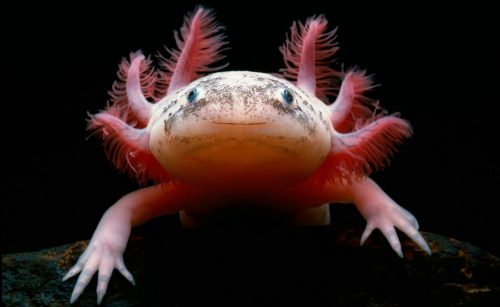Image courtesy of www.bigalspets.com.
With their feathery gills and large mouths, axolotls may look like aliens from another planet. But underneath their wacky appearance may be the key to future wound healing therapeutics. Known as biology’s favorite amphibian, axolotls have incredible powers of regeneration—they can regrow entire limbs and organs without scarring, even as fully formed adults.
Because of their abilities and their genetic similarity to humans, axolotls have become the favored model organism to identify the necessary genes controlling regeneration. The key challenge to studying them is the size of their genomes, which, at ten times larger than the human genome, is one the largest fully sequenced genomes we know. Performing traditional genetic screens on them is time and resource intensive. In a new study published in the journal eLife, researchers in the laboratory of Craig Crews, the John C. Malone Professor of Molecular, Cellular and Developmental Biology and Professor of Chemistry and Pharmacology, have developed a novel screening procedure that can circumvent those issues.
With the development of next-generation sequencing and the CRISPR/Cas9 gene-editing technology, it is now possible to turn off certain genes in every cell of an organism to determine its function. Dr. Parker Flowers, co-first author of the paper, was the first scientist to implement CRISPR/Cas9 in axolotls, but the procedure was not perfect. “One of the problems with this technique was that it would make animals that had a hundred different mutations throughout its body, creating a mosaic,” Flowers explained. While this inconsistency is typically detrimental to genetic studies, he and Lucas Sanor, the co-first author on this study, were able to use this mosaicism to their advantage. “These mutations became a way to track different populations of cells, making a genetic mark that would label all the cells that came from that original cell in which the mutation occurred,” Flowers said.
Sanor sequenced these genetic marks to track different cell populations in an axolotl limb. He searched for the markers before and after an amputated limb regenerated. If a certain group of cells had a nonfunctional copy of a gene required for regeneration, those cells would be reduced in number or absent from the new limb since they would not be able to successfully regenerate. Using this methodology, Sanor was able to screen a list of 25 candidate genes and found catalase and fetub, two genes that play an essential role in tail regeneration.
While the involvement of these particular genes was not surprising given previous literature, these results did provide validation for their screening method, which was the highlight of their study. “We’ve provided a tool for how people can address multiple genes at once and perform a screen much more rapidly in axolotls,” Sanor explained.
In the future, Flowers hopes that their protocol can be used to screen even more genes in axolotls and other model organisms. However, his long-term vision for his work is much more ambitious. “The ultimate goal of this research is to improve human regenerative therapy,” Flowers said. While human regeneration was once thought to only exist in science fiction, the axolotl may well be bringing it one step closer to reality.

